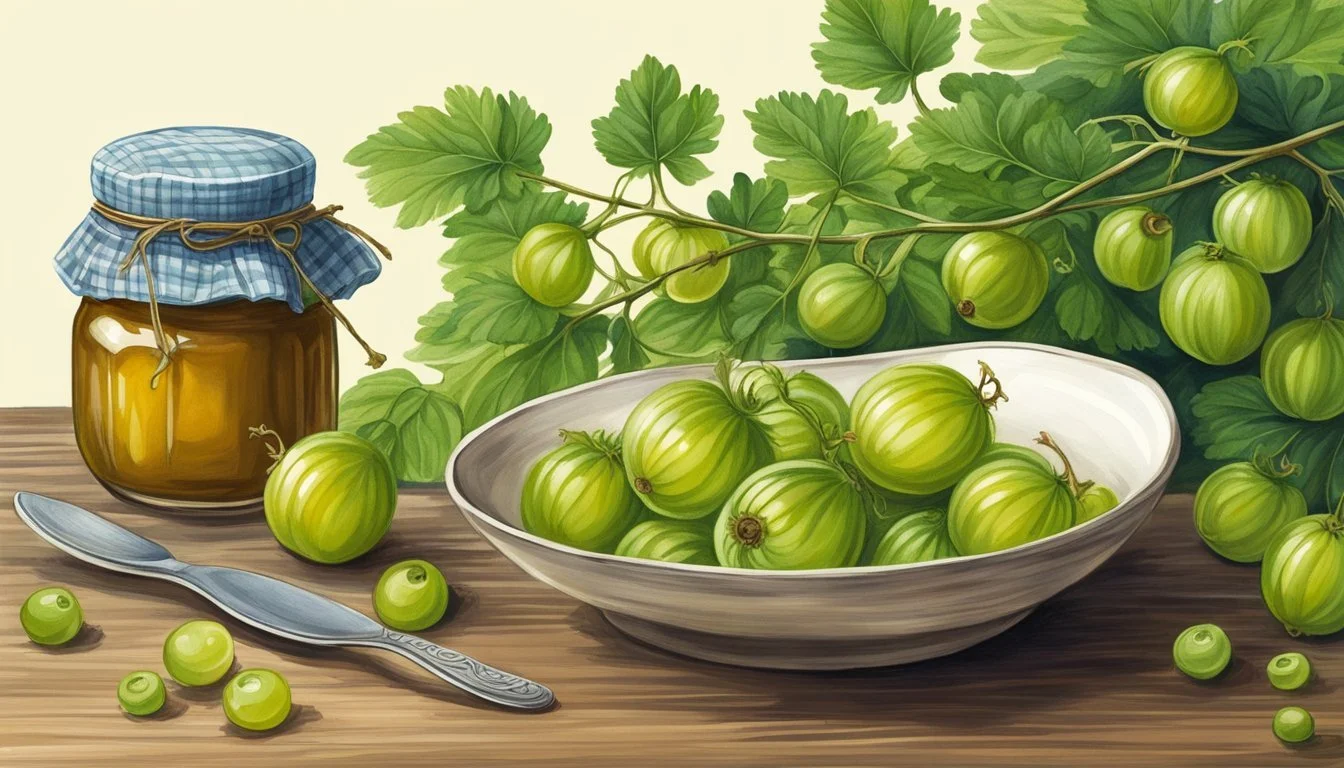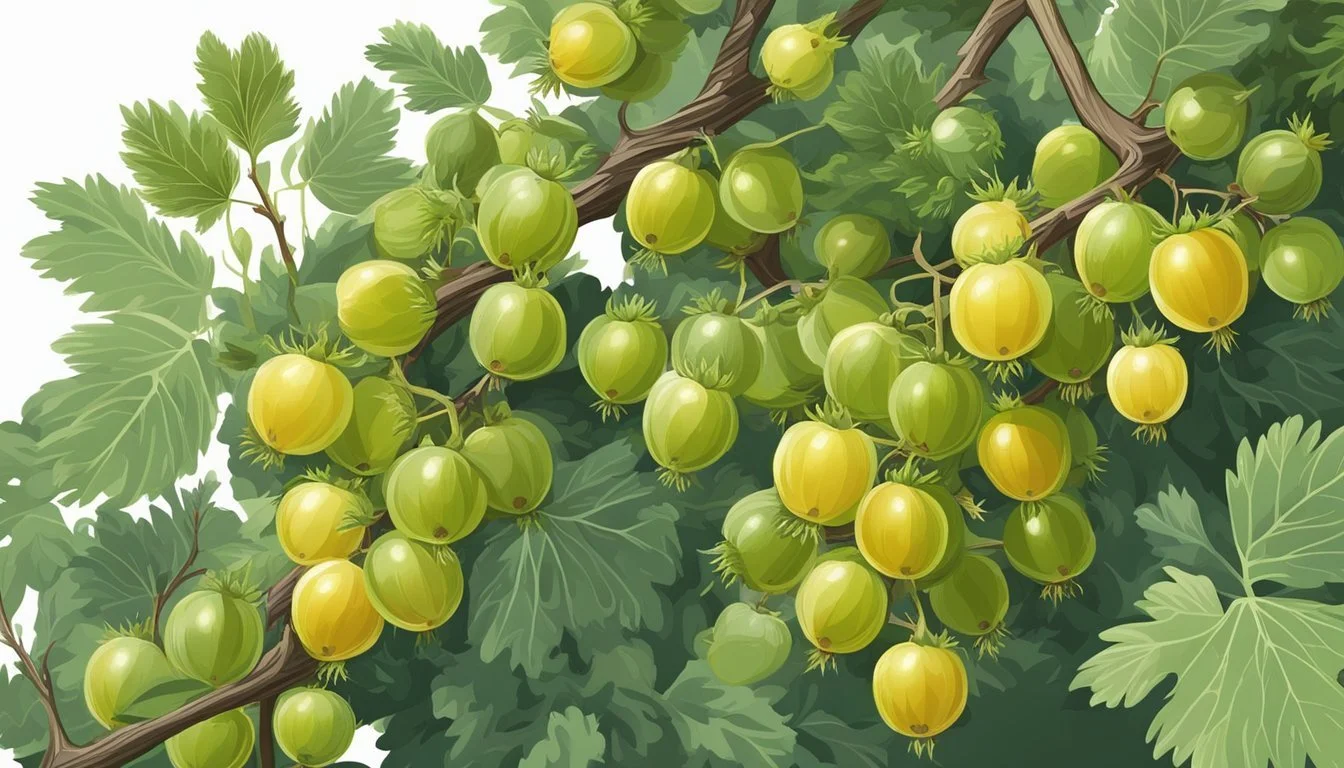How Do You Eat a Gooseberry?
Simple Steps for Enjoying this Tangy Fruit
Gooseberries are a distinctive fruit known for their sweet and tart flavor profile, commonly compared to green apples, lemons, and sour grapes. They are the berry from gooseberry bushes, coming in a variety of species, with the European gooseberry and the American gooseberry being the most noted. These berries offer a burst of flavor that is both unique and refreshing. Rich in nutrients, gooseberries provide a healthy option for those seeking to incorporate more fruits (What wine goes well with fruits?) into their diet.
When it comes to consuming gooseberries, people may appreciate their versatility. This small, orb-shaped fruit encased in a veiny skin can be enjoyed raw or as a part of numerous culinary creations. From being a tangy addition to salads, to being cooked into sweet jams and desserts, gooseberries can be adapted to suit a range of taste preferences and recipes.
Eating gooseberries is simple and straightforward. They can be consumed right after a thorough washing to remove any residue from the surface. For those new to the fruit, the complexity of its flavor invites exploration through various forms of preparation, be it stewing, baking, or simply enjoying them as a fresh, juicy treat. The unique taste and nutritional benefits of gooseberries make them an enticing option for anyone looking to expand their fruit palate.
Understanding Gooseberries
Gooseberries are a distinctive fruit known for their vibrant colors and nutritional benefits. Depending on the variety, they offer an impressive range of vitamins and minerals, making them a valuable addition to a health-conscious diet.
Varieties and Colors
Gooseberries are typically classified into two main species: the European gooseberry (Ribes uva-crispa) and the American gooseberry (Ribes hirtellum). The European varieties are larger and often subject to a federal ban in some regions to protect pine forests from disease, which the American species are resistant to. Gooseberry colors span across a red, green, purple, and yellow palette, making them as visually diverse as they are in flavor.
Nutritional Profile
A gooseberry's nutritional profile is quite dense, considering its low calorie content. Here is a snapshot of their nutritional value per 1 cup of raw gooseberries:
Calories: 66
Fat: 0 g
Carbohydrates: 15 g
Fiber: 6.5 g
Protein: 1 g
Vitamin C: 46% Daily Value (DV)
Minerals:
Potassium
Manganese
These berries are not only a great source of fiber but also rich in vitamins and antioxidants, supporting overall health.
Historical Context
Gooseberries have been enjoyed for centuries, with their cultivation spanning across Europe and later introduced to North America. Despite facing bans in some parts of North America due to concerns about spreading disease to pine trees, they have continued to be a popular garden fruit where they can be grown. Their longevity in human diets is a testament to their health benefits and versatility in culinary uses.
Preparation and Consumption
Gooseberries are versatile fruits that can be enjoyed in various ways, from eating them raw to incorporating them into recipes. Proper preparation is key to maximizing their unique sweet-tart flavor profile.
Selecting and Picking
When choosing gooseberries, one should look for berries that are ripe, which typically means they will be plump and have a slightly soft skin. The size of ripe gooseberries is comparable to that of cherry tomatoes. They are generally available fresh during their season, which occurs in summer, at farmers' markets and grocery stores. When picking gooseberries, it's important to gently pluck them from the bush, ensuring the stem is intact, to preserve their quality.
Cleaning and Storage
Once picked, gooseberries should be washed in lukewarm water before consumption or storage. This helps remove any dirt and residual pesticides. To prepare for storage, stems and brown appendages should be removed. Gooseberries can be stored in a container in the refrigerator to keep them fresh. For longer preservation, they can be frozen or even canned.
Eating Gooseberries Raw
Eating them raw allows one to experience the full range of their taste, from sour to sweeter notes, depending on ripeness. Prior to eating, the skin of the gooseberry is typically smooth and may be consumed as is. For those who find the taste too tart, sprinkling a little sugar on the gooseberries can make them sweeter. Gooseberries make for a nutritious snack, packed with vitamin C and fiber.
Cooking Techniques
Gooseberries, versatile in their culinary uses, can be the star ingredient in both sweet and savory dishes. Their tart flavor and vibrant color add character to recipes that range from desserts to main courses.
Creating Sweet Dishes
For those with a sweet tooth, gooseberries can be transformed into a variety of desserts. They are commonly used in making jams and jellies, where the fruit is cooked with sugar and sometimes pectin to set. A classic technique involves simmering the berries until they burst, releasing their natural pectin, which adds a lush, spreadable consistency to the jam.
Pies & Tarts: Gooseberries make an excellent pie filling. They are often sweetened with sugar and may be thickened with a starch. The traditional gooseberry pie pairs the fruit with a buttery pastry.
Syrup: By cooking down gooseberries with sugar and water, chefs can create a vibrant syrup perfect for drizzling over ice cream or pancakes.
Preparing Savory Recipes
In savory applications, gooseberries offer an intriguing balance of tartness that complements richer foods.
Sauces & Chutneys: A gooseberry chutney, which includes the fruit, sugar, and vinegar, along with spices, can be paired with meats or cheeses. Similarly, a savory gooseberry sauce can be made by reducing the fruit with minimal sugar and perhaps onions or herbs, providing a tart accent to dishes such as roasted meats (What wine goes well with roasted meats?) or poultry.
Savory Pairings: Gooseberries can also be incorporated as a fresh element in salads or cooked lightly to be served as a side dish, where their acidity cuts through the richness of foods like pork or duck.
Health and Wellness
Gooseberries, with their rich nutrient profile, play a significant role in promoting health and wellness. Packed with vitamins and antioxidants, they offer a range of health benefits and have a positive impact on both body and mind.
Benefits and Remedies
Gooseberries are notably nutritious and offer a plethora of health benefits. They are an excellent source of vitamin C, an antioxidant that bolsters the immune system and skin health. The presence of antioxidant compounds, like quercetin and ellagic acid, equips gooseberries with the potential to combat oxidative stress and may lower the risk of certain cancers.
Diabetes: Their impact on blood sugar regulation is valuable, particularly in managing type 2 diabetes.
Cancer: Compounds such as ellagic acid have been researched for their ability to inhibit cancer cell growth.
Nutritious: Gooseberries are low in calories yet high in fiber, making them a filling, healthful snack.
Impact on Body and Mind
The influence of gooseberries extends beyond physical health, possibly affecting cognitive health as well. Components in gooseberries may have neuroprotective effects and enhance memory, suggesting a role in the prevention of memory-related disorders.
Oxidative Stress: Regular consumption of antioxidant-rich gooseberries can help in reducing oxidative stress, which is a precursor to many chronic diseases.
Mental Clarity: Nutrients found in gooseberries could potentially improve mental clarity and cognitive function, though more research is needed to fully establish these effects.
By incorporating gooseberries into one's diet, one may be able to harness these profound health benefits. The fruit's versatility allows it to be an easy addition to various meals and snacks, thereby enhancing overall wellness.
Gooseberry Products and Alternatives
In exploring gooseberry products and alternatives, one finds both commercially available items and a variety of ways they can be utilized or substituted at home. This section dives into where you can find gooseberry items and how you can incorporate or replace them in recipes and home usage.
Commercial Availability
Commercially, gooseberries can be found in various forms that suit different culinary needs. Fresh gooseberries are seasonal and may not always be available; however, consumers have the option to purchase canned gooseberries which can be used in making desserts or as an accompaniment to meals. For those seeking a sweeter variant, gooseberry syrups are sold, often used to impart flavor in beverages or as a topping.
For convenience, dried gooseberries offer a longer shelf life and can be a handy snack or an addition to cereals and trail mixes. In regions where gooseberries are less common, one may find amla—the Indian gooseberry—as a dietary supplement or in the form of amla powder, renowned for its health benefits.
Home Uses and DIY
At home, gooseberries can be incorporated into recipes in much the same way as other tart fruits such as grapes, currants, or rhubarb. They can be cooked down to create jams or compotes, with sugar added to balance their inherent tartness.
For a refreshing drink, gooseberry juice can be prepared by boiling the fruit with water and straining, perhaps sweetening it to taste afterwards. Gooseberries are a versatile ingredient and can also be pickled for a unique condiment. Those interested in DIY alternatives can substitute gooseberries in any recipe calling for similarly tart fruits, making them a flexible addition to the kitchen pantry.
Growing and Harvesting
In cultivating gooseberries, one's success hinges on understanding the nuances of plant care and timing. Addressing challenges like pests and diseases early is crucial for a fruitful harvest.
Cultivation Tips
The Ribes genus, which includes gooseberry varieties, thrives in well-drained soil supplemented with organic matter. Planting is best done in the cool seasons of fall or early spring. Each bush should be spaced 4-5 feet apart, and if space is limited, they may be trained against walls or fences.
Soil preparation: Dig a hole approximately 2x2 feet and 1 foot deep, incorporating a layer of compost at the bottom to foster healthy growth.
Watering: After planting, create a soil lip about a foot in diameter to retain water and avoid runoff.
Mulching: This helps maintain soil moisture and control weeds.
Harvest Season: Gooseberries are typically ready for harvest from June to July, depending on the variety and local climate conditions.
Pest and Disease Management
Gooseberries can fall prey to various pests and diseases; however, being proactive can mitigate these threats. Fungal diseases are a common issue, but can be managed through proper plant care and hygiene practices.
Sawfly: Regular inspection of plants for larvae and adequate spacing to improve air circulation can prevent infestations.
Mildew: To manage mildew, avoid overhead watering and space plants to allow for ample air flow.
By adhering to these cultivation and pest management strategies, gardeners can expect a robust gooseberry harvest.





